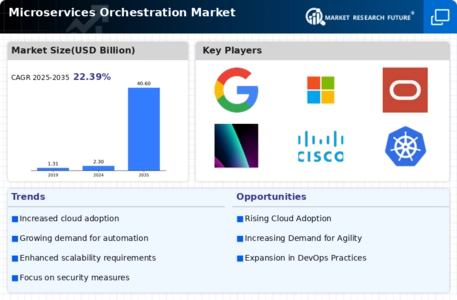Growing Demand for Scalability
The Microservices Orchestration Market is experiencing a notable surge in demand for scalable solutions. Organizations are increasingly adopting microservices architecture to enhance their ability to scale applications efficiently. This shift is driven by the need for businesses to respond swiftly to changing market conditions and customer demands. According to recent data, the microservices orchestration market is projected to grow at a compound annual growth rate of over 20% in the coming years. This growth is indicative of the industry's recognition of the importance of scalability in application development and deployment. As companies seek to optimize their operations, the orchestration of microservices becomes a critical component in achieving seamless scalability, thereby driving the overall market forward.
Enhanced Operational Efficiency
Operational efficiency remains a pivotal driver in the Microservices Orchestration Market. Organizations are increasingly leveraging microservices orchestration to streamline their processes and reduce operational costs. By breaking down applications into smaller, manageable services, companies can enhance their deployment speed and improve resource utilization. This approach not only minimizes downtime but also allows for more efficient troubleshooting and maintenance. Market analysis indicates that businesses utilizing microservices orchestration can achieve up to a 30% reduction in operational costs. This efficiency is particularly appealing to enterprises looking to maximize their return on investment while maintaining high service quality. As such, the drive for operational efficiency continues to propel the growth of the microservices orchestration market.
Integration of Advanced Technologies
The integration of advanced technologies is a crucial driver in the Microservices Orchestration Market. The convergence of technologies such as artificial intelligence, machine learning, and the Internet of Things is reshaping how microservices are orchestrated. These technologies enable more intelligent decision-making and automation within orchestration processes, enhancing overall system performance. Market Research Future reveal that organizations implementing AI-driven orchestration solutions can achieve up to a 50% improvement in operational efficiency. This integration not only streamlines workflows but also allows for predictive analytics, enabling businesses to anticipate issues before they arise. As the demand for sophisticated orchestration solutions grows, the incorporation of advanced technologies is likely to play a pivotal role in shaping the future of the microservices orchestration market.
Rising Need for Agility in Development
The Microservices Orchestration Market is significantly influenced by the rising need for agility in software development. In an era where rapid deployment and iterative development are paramount, organizations are turning to microservices orchestration to facilitate agile methodologies. This approach allows development teams to work on individual services independently, thereby accelerating the overall development cycle. Recent studies suggest that companies adopting microservices orchestration can reduce their time-to-market by as much as 40%. This agility not only enhances competitiveness but also enables businesses to innovate more rapidly in response to customer feedback and market trends. Consequently, the demand for agile development practices is a key driver of growth within the microservices orchestration market.
Increased Focus on Security and Compliance
Security and compliance concerns are becoming increasingly prominent in the Microservices Orchestration Market. As organizations migrate to microservices architectures, they face new security challenges that necessitate robust orchestration solutions. The need to ensure data integrity and compliance with regulations is driving the adoption of advanced security measures within microservices orchestration frameworks. Market data indicates that companies prioritizing security in their microservices strategies are likely to see a 25% decrease in security incidents. This focus on security not only protects sensitive information but also builds customer trust, which is essential for long-term success. As such, the emphasis on security and compliance is a significant factor influencing the growth trajectory of the microservices orchestration market.


















Leave a Comment